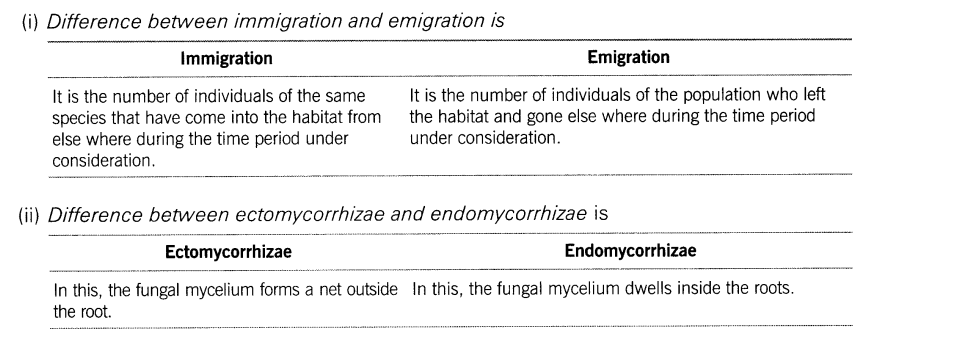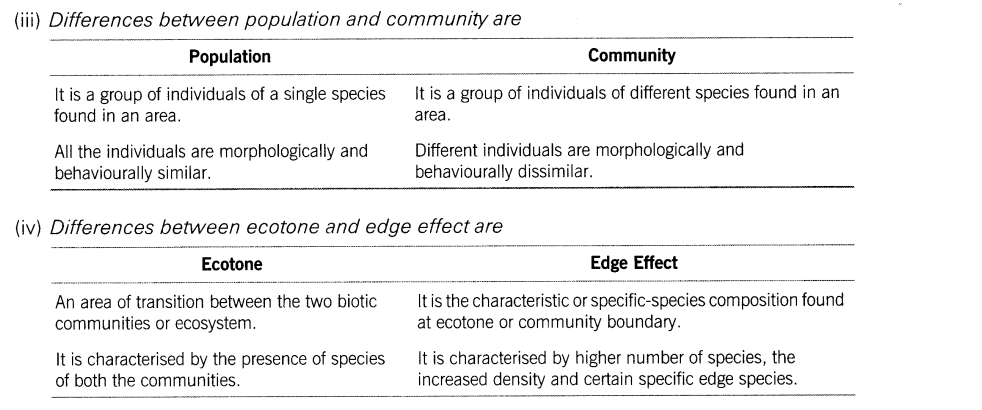CBSE Sample Papers for Class 12 Biology Solved Set 6
Section A
1.Any type of failure of testes to descend into the scrotum induces sterility in human males. Explain.
2.Phenomenon of DNA replication has a semiconservative nature. Explain the statement.
3.Mother’s milk is often termed as the most appropriate food for a new born infant. Give reason.
4.It is now possible to produce multiple copies of even a very small DNA template. Mention the fact how it happens.
5.Eichhornia crassipes is often nicknamed as ‘Terror of Bengal’. Justify.
Section B
6.Any abnormal arrangement of one or more chromosomes in a body is known to be a chromosomial disorder. Both Down’s syndrome and Klinefelter’s syndrome are one such type. Cite the differences between the nature and symptoms of the two.
7.What do you mean by the term ‘standing crop’ in an ecosystem? Draw a pyramid of biomass, when a small standing crop of phytoplanktons supports a large standing crop of zooplanktons in the sea.
Or
(i) Compare the grazing food chain and detritus food chain in terms of origin.
(ii) Which among the two is the major contributor to energy flow in aquatic ecosystem?
8.The excreta (dung) of cattle is used for the generation of biogas in many areas. Mention the function performed by it.
9.Radhika went on a school trip to some garden and started sneezing after she reached there. In the evening when she came back home, she was feeling all fine. What could be the reason behind her such condition? Also tell the type of antibody being produced by the body as a response against it.
10.What contribution were made by TH Morgan as a geneticist in the field of genetics? Give any two of them.
Section C
11.Answer the question given below
(i) Identify the parts labelled A, B, C and D in the diagram of a seed.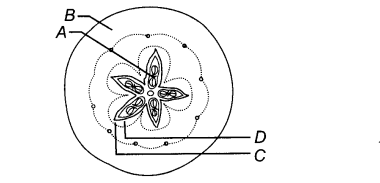
(ii) State the reason behind the fact that why some fruits are seedless i.e. contain or empty or non-viable seeds with the help of a suitable example.
12.Which three hypothesis explains the logic behind the fact that why the tropics shows greatest level of species richness?
13.Explain some major ways to prevent and control the drug and alcohol abuse among the adolescents.
14.State the importance behind testing of new plant varieties in a geographically vast country like India.
15.(i) Eco RI is a well known restriction endonuclease. How it is named so? Give details.
(ii) Why it is essential to have a selectable marker in a cloning vector?
16.Explain the process behind a Polymerase Chain Reaction (PCR).
17. Write a note on following.
(i) Mycorrhiza (ii) Cyanobacteria (iii) Nitrogen-fixing Bacteria
18. The base sequence in one of the strands of DNA is TAGCATGAT.
(i) Give the base sequence of the complementary strand.
(ii) How are these base pairs held together in a DNA molecule?
(iii) Explain the base complementarity rule. Give the name of the scientist who framed this rule.
19.A couple visited a Doctor to got to know whether their foetus (unborn child) is suffering from any chromosomal disorder, to the couple. Which is incurable? What suggestions would you give under such circumstances?
20.(i) Describe all the barriers of innate immunity.
(ii) When do innate immunity become active?
Or
Diagrammatically trace the life cycle of a malarial parasite in the human body when bitten by an infected female Anopheles.
21.Haemophilia is a sex-linked recessive disorder of humans. The pedigree chart given below shows the inheritance of haemophilia in one family. Study the pattern of inheritance and answer the questions given.
(i)Give all the possible genotypes of the members 4,5 and 6 in the pedigree chart.
(ii) A blood test shows that the individual 14 is a carrier of haemophilia. The member numbered as 15 has recently married to number 14. What is the probability that their first child will be a haemophilic male?
22.Give diagrammatic representation of Miller’s experiment.
Section D
23.Anil was waiting at a bus stop. Many passengers alongwith their kids were on their way to school. A bus came and painted the children with black smoke being ejected from the exhaust pipe. Anil immediately stopped the bus and called the conductor and driver to show what they had done. Passengers waiting in the bus stop supported Anil, while those on board became restless for being delayed.
(i) Why are children more affected by vehicle exhausts?
(ii) Cars are seen with Bharat stage IV stickers. What does it imply?
(iii) How do catalytic converters reduces vehicular gas emission?
(iv) What values did Anil promote through his action?
Section E
24.Examine the flowchart given below. And identify the name of the hormones involved at each stage inside a female body. Also explain the roles performed by each of them.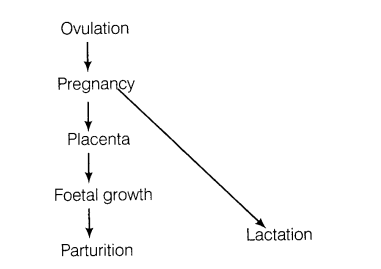
Or
Discuss the post-zygotic events in human female that leads to a process of implantation in uterus with a neat and a well labelled diagram.
25.State the aim and describe Messelson and Stahl’s experiment in detail.
Or
(i) What did Messelson and Stahl observed? When
(a) They cultured coli in a medium containing 15NH4C1 for a few generations and centrifuged the content?
(b) They transferred one such bacterium to the normal medium of NH4 Cl and cultured for two generations?
(ii) What did Messelson and Stahl conclude from his experiment? Explain only with the help of diagrams.
(iii) Which is the first genetic material? Give reasons in support of your answer.
26.Explain the following terms (with example).
(i) Migration (ii) Aestivation
(iii) Hibernation (iv) Diapause
Or
Cite the difference between the following terms used for organism and its population
(i) Immigration and Emigration
(ii) Ectomycorrhizae and Endomycorrhizae
(iii) Population and Community
(iv) Ecotone and Edge Effect
(v) Keystone Species and Critical Link species.
Answers
Section A
1.Any type of failure of testes to descend into the scrotum induces sterility in human males. Explain.
Ans.Any minor failure of testes to descend into the scrotum induces sterility because of the higher temperature in the abdomen of the human males which is not suitable forthe development of the sperms.
2.Phenomenon of DNA replication has a semiconservative nature. Explain the statement.
Ans.Replication of DNA acts semi-conservatively in nature as it describes the mechanism by which the each DNA molecule would produce two copies each containing one of the original strand (parental) and one newly synthesised strand.
3.Mother’s milk is often termed as the most appropriate food for a new born infant. Give reason. Ans.It is considered so because mother’s milk provides immunity as it contains abundant IgA antibodies to protect the newly born child from foreign antigens and other harmful substances.
4.It is now possible to produce multiple copies of even a very small DNA template. Mention the fact how it happens.
Ans.When an alien DNA is linked with the origin of replication, the DNA is able to multiply itself in host organism and produces multiple copies of its template.
5.Eichhornia crassipes is often nicknamed as ‘Terror of Bengal’. Justify.
Ans.Eichhornia crassipesis often nicknamed as ‘Terror of Bengal’ because it grows very fast in the water-body and depletes the dissolved oxygen hence, disturbing the complete ecosystem dynamics of the water-body.
Section B
6.Any abnormal arrangement of one or more chromosomes in a body is known to be a chromosomial disorder. Both Down’s syndrome and Klinefelter’s syndrome are one such type. Cite the differences between the nature and symptoms of the two.
Ans.Differences between Down’s syndrome and Klinefelter’s syndrome is given below
(i) Down’s Syndrome is a genetic disorder which arises due to trisomy copy of the chromosome number 21 i.e.(2/7 + 1). Individuals with this abnormality are short statured with small rounded face, have furrowed tongue and partially open mouth. Palm is broad with characteristic palm crease. Physical psychomotor and mental development is retarded.
(ii) Klinefelter’s Syndrome is a genetic disorder which arises due to the presence of additional copy of X-chromosome resulting into a karyotype of 47 i.e. (XXY). Overall development of masculine character occurs. Feminine development (development of breast) is also expressed and individuals are sterile.
7.What do you mean by the term ‘standing crop’ in an ecosystem? Draw a pyramid of biomass, when a small standing crop of phytoplanktons supports a large standing crop of zooplanktons in the sea.
Or
(i) Compare the grazing food chain and detritus food chain in terms of origin.
(ii) Which among the two is the major contributor to energy flow in aquatic ecosystem?
Ans.Each trophic level has a certain mass of living material at particular time known as standing crop which is measured as the biomass of living organisms (biomass) or the number in a unit area. The biomass of a species is expressed in terms of fresh or dry weight
Or
(i) Grazing Food Chain (GFC) begins from producers or green plants whereas, detritus Food Chain (DFC) begins from remains of dead plants such as leaves, bark, flowers and dead remains of animals.
(ii)In aquatic ecosystem, grazing food chain is the most or major contributor of energy flow than detritus food chain.
8.The excreta (dung) of cattle is used for the generation of biogas in many areas. Mention the function performed by it.
Ans.Cattle excreta (dung) is used for the generation of biogas because it is rich in methanogens.
Function Methanogens are found in anaerobic sludge and easily digest cellulosic material present in rumen of cattles, e.g. Methanobacterium.
9.Radhika went on a school trip to some garden and started sneezing after she reached there. In the evening when she came back home, she was feeling all fine. What could be the reason behind her such condition? Also tell the type of antibody being produced by the body as a response against it.
Ans.Radhika for no explained reason must had suffered from some kind of allergy either from the dust or may be by the pollen grains of the flowers etc. Such substances are called allergens. Our body eventually produces IgE antibodies as a response against such allergens.
10.What contribution were made by TH Morgan as a geneticist in the field of genetics? Give any two of them.
Ans.T. H Morgan, was known as an American genetist been awarded with a Nobel Prize in the year 1933, He made many contributions in the field of genetics, two of them are as follows.
(i) Found Drosophilla me/anogaster (fruit fly) and proved it as a better model for experiments on genetics value to their easy rearing and ability of being multiply throughout the year.
(ii) Had established, the presence of genes over the chromosomes.
Section C
11.Answer the question given below
(i) Identify the parts labelled A, B, C and D in the diagram of a seed.
(ii) State the reason behind the fact that why some fruits are seedless i.e. contain or empty or non-viable seeds with the help of a suitable example.
Ans.(i) A— Seed B— Thalamus C— Endocarp D— Mesocarp.
(ii) This is because they are produced without fertilisation and are called parthenocarpic fruits. g. Banana.
12.Which three hypothesis explains the logic behind the fact that why the tropics shows greatest level of species richness?
Ans.Three hypotheses for explaining the greatest level of species richness in tropics are
(i) Tropics are rich in species because in the past, temperate regions were subjected to the frequent glaciations, while tropics remained relatively undisturbed for millions of years, thus, they got long time for species diversification. (ii) Tropical environments are more constant and predictable. Therefore, it promotes niche specialisation and leads to the greater diversity thus, tropics are more species rich.
(iii) Tropics have more solar energy exposure, which contributes to the higher productivity and indirectly leads to the greater diversity.
13.Explain some major ways to prevent and control the drug and alcohol abuse among the adolescents.
Ans.Some important measures that should be taken for the prevention and control of drugs and alcohol abuse among adolescents are
(i) Avoid undue peer pressure. (ii) Education and counselling.
(iii) Seeking help from parents and peers, (iv) Looking for danger signs.
(v) Seeking professional and medical help.
14.State the importance behind testing of new plant varieties in a geographically vast country like India.
Ans.Before the generation of new plants through plant breeding programs, plant needs to be evaluated for their yield and other agronomic traits of quality, disease resistance, etc.
The testing is done on the farmer’s field for atleast three growing seasons, at different locations in the country representing all the agroclimatic zones, where the crop is usually grown. The material is thus, evaluated in comparison to the best available local crop cultivar known as a check or reference cultivar and finally the product is released.
15.(i) Eco RI is a well known restriction endonuclease. How it is named so? Give details.
(ii) Why it is essential to have a selectable marker in a cloning vector?
Ans.(i) ECORI is derived from Escherichiacoli RY13. It is named as follows
- The capital letter Ecomes from Escherichia(genus).
- The letter COcome from Coli(Species).
- The letter Rcomes from RY13 (strain)
- The Roman number I indicate it was the first enzyme isolated from the bacterium E. coli RY15.
(ii) It is essential to have a selectable marker in cloning vector because it helps in identifying and eliminating non-transformants and selectively permitting the growth of transformants.
16.Explain the process behind a Polymerase Chain Reaction (PCR).
Ans.PCR (Polymerase Chain Reaction) is a reaction in which amplification of specific DNA sequences is carried out/a? vitro.
The process of PCR is given below
(i) Denaturation c/s DNA (double stranded DNA) is denatured and separated by applying high temperature of 95°C for 15 s.
(ii) Annealing Two sets of primers are added which anneal to the 31 end of each separated strand. These primers act as the initiators of replication.
(iii) Extension In this step, DNA polymerase extends the primers by adding nucleotides complementary to the template provided in the reaction.
(a) A thermostable DNA polymerase i.e. taq polymerase is used in the reaction, which can tolerate the high temperature of the reaction.
(b) All these steps are separated many times to obtain several copies of desired DNA.(l)
17. Write a note on following.
(i) Mycorrhiza (ii) Cyanobacteria (iii) Nitrogen-fixing Bacteria
Ans.(i) Mycorrhiza It is a symbiotic association between fungus and the roots of higher plants.
The fungus absorbs water and minerals from the soil and passes them on to the plant. The carbohydrates synthesised by the plant are absorbed by the fungus.
(ii) Cyanobacteria They are autotrophic microbes found in aquatic and terrestrial environment. They help in nitrogen fixation, e.g. Anabaena and Nostoc. Cyanobacteria are used in paddy fields as an important fertiliser. (iii) Nitrogen-fixing bacteria These are either symbiotic bacterium like Rhizobium or free-living bacteria, Azospirillum and Azotobacter, which fix atmospheric nitrogen and enrich the soil nutrients.
18. The base sequence in one of the strands of DNA is TAGCATGAT.
(i) Give the base sequence of the complementary strand.
(ii) How are these base pairs held together in a DNA molecule?
(iii) Explain the base complementarity rule. Give the name of the scientist who framed this rule.
Ans.(i) ATCGTACTA
(ii) Base pairs are held together by weak hydrogen bonds, Adenine pairs with Thymine by two H-bonds and Guanine pairs with Cytosine forming three H-bonds.
(iii) Base complementarity rule for a double-stranded DNA states that the ratios between Adenine and Thymine and Guanine and Cytosine are constant and equal to one. Ervin Chargaff framed this rule.
19.A couple visited a Doctor to got to know whether their foetus (unborn child) is suffering from any chromosomal disorder, to the couple. Which is incurable? What suggestions would you give under such circumstances?
Ans.If the foetus is suffering from any chromosomal disorder that is incurable, the couple should go for MTP (Medical Termination of Pregnancy). The suggestion can be given as
(i) MTP is considered relatively safe only during the first trimester, i.e. upto 12 weeks of pregnancy.
(ii) Second trimester abortions are proceeded to be much more risky.
20.(i) Describe all the barriers of innate immunity.
(ii) When do innate immunity become active?
Or
Diagrammatically trace the life cycle of a malarial parasite in the human body when bitten by an infected female Anopheles.
Ans.(i) Barriers of innate immunity are as follow
(a) Physical Barriers Such as, skin, mucous, coating of the epithelium, lining of respiratory, gastrointestinal and urogenital tracts.
(b) Physiological Barriers Such as, acid in stomach, saliva in the mouth, tears from eyes.
(c) Cellular Barriers Certain types of leukocytes (WBC) of our body like, Polymorphonuclear leukocytes (PMNL neutrophils), monocytes, natural killer cells and macrophages.
(d)Cytokine Barriers Proteins called interferons being secreted by Virus infected cell, (ii) Innate immunity in an individual becomes active as soon as any foreign material (virus,bacteria and pathogen) enters the body. Or
Life cycle of a Malaria parasite in the human body is given below as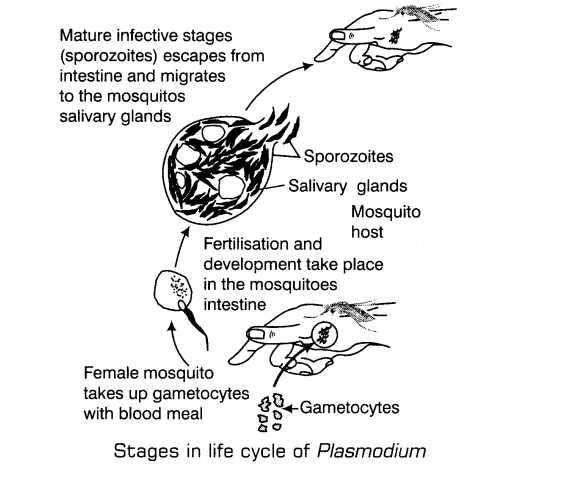
21.Haemophilia is a sex-linked recessive disorder of humans. The pedigree chart given below shows the inheritance of haemophilia in one family. Study the pattern of inheritance and answer the questions given.
(i)Give all the possible genotypes of the members 4,5 and 6 in the pedigree chart.
(ii) A blood test shows that the individual 14 is a carrier of haemophilia. The member numbered as 15 has recently married to number 14. What is the probability that their first child will be a haemophilic male?
Ans.(i) Possible genotype of member 4 is XX or XXh
Possible genotype of member 5 is XhY
Possible genotype of member 6 is XY
(ii) According to the pedigree given, if the member 15 of a family gets married to a member 14 then the probability of first child to became haemophilic male will be 25%.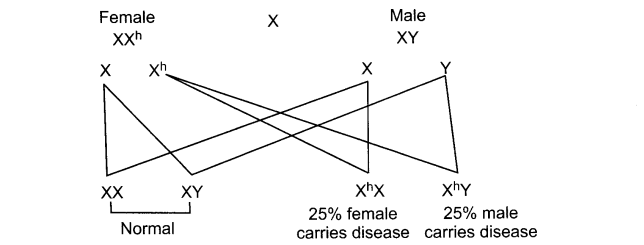
Thus, heterozygous female (carrier) for haemophilia may transmit the disease to sons.
22.Give diagrammatic representation of Miller’s experiment.
Ans.Miller’s Experiment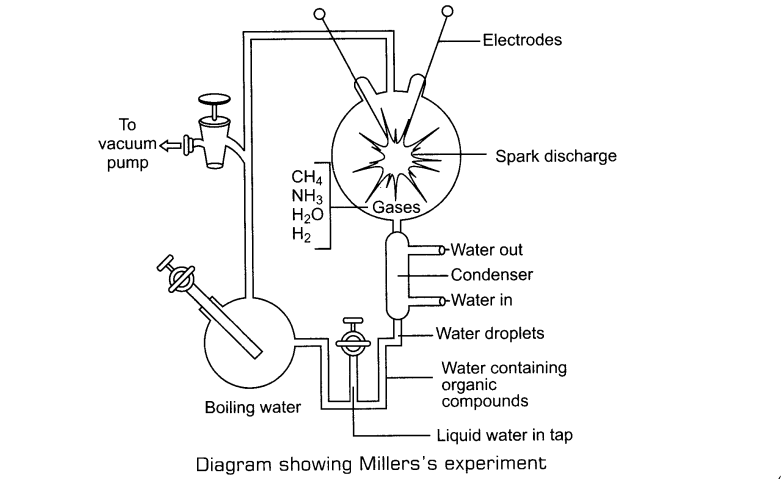
Section D
23.Anil was waiting at a bus stop. Many passengers alongwith their kids were on their way to school. A bus came and painted the children with black smoke being ejected from the exhaust pipe. Anil immediately stopped the bus and called the conductor and driver to show what they had done. Passengers waiting in the bus stop supported Anil, while those on board became restless for being delayed.
(i) Why are children more affected by vehicle exhausts?
(ii) Cars are seen with Bharat stage IV stickers. What does it imply?
(iii) How do catalytic converters reduces vehicular gas emission?
(iv) What values did Anil promote through his action?
Ans.(i) Height of the smoke emitted from exhaust pipe is closer to the height of the children.
(ii) It indicates that the vehicles comply with the new auto fuel policy. At present, vehicles complying Euro IV or equivalent BS-IV norms are to apply in the identified 11 cities, rest of the country to follow Euro III / BS-III norms.
(iii) In these devices platinum, palladium and rhodium are used as catalysts. As the exhaust passes through the converter, unburnt hydrocarbons are converted into C02and H2 Carbon monoxide and nitric oxide are changed into C02 and N2 gas respectively. Vehicles fitted with such equipment should run on unleaded petrol only. Since, lead in petrol inactivates the catalysts.
(iv) Anil shows alertness, responsibility and firmness in tackling a problem. He expresses boldness towards environment consciousness.
Section E
24.Examine the flowchart given below. And identify the name of the hormones involved at each stage inside a female body. Also explain the roles performed by each of them.
Or
Discuss the post-zygotic events in human female that leads to a process of implantation in uterus with a neat and a well labelled diagram
Ans.(i) During the initiation of the process in human females, a rapid release of Luteinising Hormone (LH) ruptures Graafian follicle and release ovum by the process of ovulation.
(ii) Corpus luteum then secretes a large amount of progesterone hormone that is known to be essential for the maintenance of the endometrium (a uterine layer) required for the implantation of blastocyst leading to pregnancy.
(iii) Placenta produces several hormones like human Chorionic Gonadotropin (hCG), human Placental Lactogen (hPL). Relaxin is the another hormone being produced during the later phase of pregnancy. Levels of other hormones like oestrogens, progestogens, cortisol, prolactin and thyroxine also increases, which is essential for supporting the foetal growth, metabolic changes in mother and maintenance of pregnancy.
(iv) Parturition signals the originate from the fully developed foetus the placenta induces mild uterine contractions which triggers the release of oxytocin hormone from pituitary gland. Oxytocin acts on the uterine muscle causing stronger uterine contractions.
Or
During post-zygotic events sperm and ovum gets fused together to form zygote.
The events which follows are
(i) Mitotic division starts in zygote. This is called cleavage. After repetitive division, it forms 2, 4, 8, 16 daughter cells called blastomeres. Embryo with 8-16 blastomeres forms morula which continues to divide and transform into blastocyst.
(ii) The blastomeres in blastocyst are arranged into an outer layer called trophoblast and an inner group of cells attached to trophoblast is called inner cell mass.
(iii) Trophoblast layerthen gets attached to endometrium (innermost layer of uterus) and inner cells mass gets differentiated as embryo.
(iv) After attachment, uterine cells divide rapidly and cover the blastocyst.
(v) As a result, blastocyst becomes embedded in the endometrium. This is called implantation
leading to pregnancy.
Diagram showing post-zygotic events is given below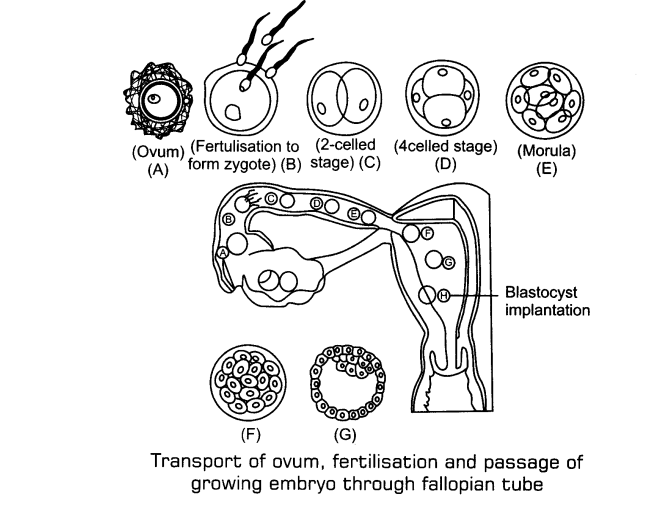
25.State the aim and describe Messelson and Stahl’s experiment in detail.
Or
(i) What did Messelson and Stahl observed? When
(a) They cultured coli in a medium containing 15NH4C1 for a few generations and centrifuged the content?
(b) They transferred one such bacterium to the normal medium of NH4 Cl and cultured for two generations?
(ii) What did Messelson and Stahl conclude from his experiment? Explain only with the help of diagrams.
(iii) Which is the first genetic material? Give reasons in support of your answer.
Ans.Messelson and Stahl in 1958, aimed to prove that DNA replicates in a semi-conservative fashion. This semi-conservative DNA replication suggests that, after the completion of replication, each DNA molecule will have one parental and one newly-synthesised s’trand.
The process of experiment conducted by them is as follows
They grew E.coli in a medium containing 15NH4CI(15 N is the heavy isotope of nitrogen) for many generations.
As a result, 15N got incorporated into newly synthesised DNA. This heavy DNA can be differentiated from normal DNA by centrifugation in caesium chloride (CsCI) density gradient.
Then they transferred the cells into a medium normal 14 NH4CI and took the samples at various definite time intervals as the cells multiplied.
The extracted DNAs were centrifuged and measured to get their densities. The DNA extracted from culture after one generation of transfer from the 15N to 14N medium showed an intermediate hybrid density.
The DNA extracted from culture after two generations showed equal amounts of light DNA and hybrid DNA.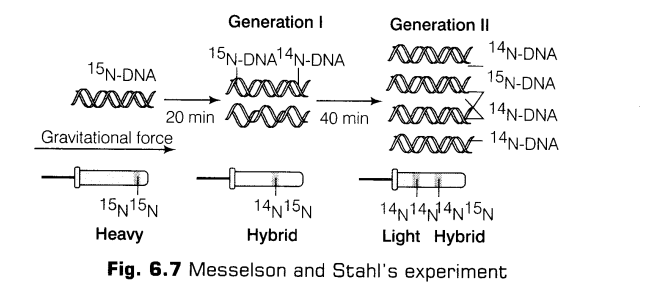
Or
(i)(a) Messelson and Stahl observed that the 15N was incorporated into the newly synthesised strand of DNA and also other nitrogen containing compounds. This heavy DNA could be distinguished from the normal DNA by centrifugation in a cesium chloride (CsCI) density gradient.
(b) DNA from such bacterium had a hybrid or intermediate density, one generation after the transfer from 15N to 14N. After another generation, it composed of equal amount of this hybrid DNA and of light DNA.
(ii) Messelson and Stahl concluded that the replication of DNA is semiconservative.
(iii)RNA is the first genetic material. This is because
(a)Essential life processes have evolved around RNA.
(b)It acts both as catalyst and genetic material.
26.Explain the following terms (with example).
(i) Migration (ii) Aestivation
(iii) Hibernation (iv) Diapause
Or
Cite the difference between the following terms used for organism and its population
(i) Immigration and Emigration
(ii) Ectomycorrhizae and Endomycorrhizae
(iii) Population and Community
(iv) Ecotone and Edge Effect
(v) Keystone Species and Critical Link species.
Ans.(i) Migration In this, organism temporarily moves away from the stressful habitat to a more
hospitable area and return when stressful period is over, e.g., birds undertake long distance migration during winter.
(ii)Aestivation It is acquired to avoid summer-related problem like heat and desiccation. For example, some fishes undergo aestivation.
(iii)Hibernation Some animals avoid the winter stress by escaping in time. g.bears undergo hibernation during winter.
(iv)Diapause It is a stage of suspended development during unfavourable conditions. g. many zooplankton species in lakes and ponds enter diapause.
Or